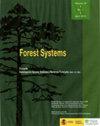Tree species consistent co-occurrence in seasonal tropical forests: an approach through association rules analysis
IF 0.7
4区 农林科学
Q3 FORESTRY
引用次数: 0
Abstract
Aim of study: Aassessing the existence of consistent co-occurrence between tree species that characterize seasonal tropical forests, using the association rules analysis (ARA), that is a novel data mining methodology; and evaluate evaluating the taxonomic and functional similarities between associated species.Area of study: forty-four seasonal forest sites with permanent plots (40.2 ha of total sample) located in Southeast Brazil, from which we obtained species occurrences.Material and methods: we applied association rules analysis (ARA) to the dataset of species occurrence in sites considering the criteria of support equal to or greater than 0.63 and confidence equal to or greater than 0.8 to obtain the first set of associations rules between pairs of species. This set was then submitted to Fisher’s criteria exact p-value less than 0.05, lift equal to or greater than 1.1 and coverage equal to or greater than 0.63. We considered these criteria to be able to select non-random and consistent occurring associations.Main results: We obtained a final result of 238 rules for semideciduous forest and 11 rules for deciduous forests, composed of species characteristic of vegetation types. Co-occurrences are formed mainly by non-confamilial species, which have similar functional characteristics (potential size and wood density). There is a difference in the importance of co-occurrence between forest types, which tends to be less in deciduous forests.Research highlights: The results point to out the feasibility of applying ARA to ecological datasets as a tool for detecting ecological patterns of coexistence between species and the ecosystems functioning.Keywords: data mining; coexistence; semideciduous forests; deciduous forests; biotic interaction.季节性热带森林中树种一致共现的关联规则分析方法
研究目的:使用一种新的数据挖掘方法——关联规则分析(ARA),评估季节性热带森林的树种之间是否存在一致的共生关系;并评估相关物种之间的分类学和功能相似性。研究区域:位于巴西东南部的44个具有永久地块的季节性森林点(总样本面积40.2公顷),我们从中获得了物种分布。材料和方法:我们将关联规则分析(ARA)应用于站点中物种发生的数据集,考虑支持度等于或大于0.63和置信度等于或大于0.8的标准,以获得第一组物种对之间的关联规则。然后将该集合提交给Fisher标准,精确p值小于0.05,升力等于或大于1.1,覆盖率等于或大于0.63。我们认为这些标准能够选择非随机和一致的关联。主要结果:我们得到了由植被类型的物种特征组成的半熟林238条规则和落叶林11条规则的最终结果。共生体主要由具有相似功能特征(潜在尺寸和木材密度)的非同科物种形成。森林类型之间的共生重要性存在差异,而落叶林中的共生重要性往往较低。研究重点:研究结果指出,将ARA应用于生态数据集作为检测物种之间共存的生态模式和生态系统功能的工具是可行的。关键词:数据挖掘;共处半熟森林;落叶林;生物相互作用。
本文章由计算机程序翻译,如有差异,请以英文原文为准。
求助全文
约1分钟内获得全文
求助全文
来源期刊

Forest Systems
FORESTRY-
CiteScore
1.40
自引率
14.30%
发文量
30
审稿时长
6-12 weeks
期刊介绍:
Forest Systems is an international peer-reviewed journal. The main aim of Forest Systems is to integrate multidisciplinary research with forest management in complex systems with different social and ecological background
 求助内容:
求助内容: 应助结果提醒方式:
应助结果提醒方式:


